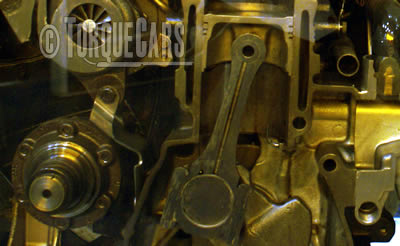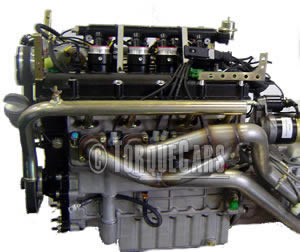The main areas for engine balancing.
"A balanced article."

We all know what happens when a wheel is fitted to a car without being balanced.
At low speeds you do not notice it but at higher speeds noticeable vibrations start to appear.
Inside an engine the rotational speeds typically reach 6-7000 rpm and, the higher the speed, the more critical it is to ensure that vibrations do not occur.
As you can see from this cross section of a piston there are a number of parts which move in each stroke of the engine, in varying directions and speeds, and if these are imbalanced you will end up with vibrations and internal stress.
The benefits of engine balancing
A balanced engine will generally be more efficient and reliable and will certainly tolerate much higher engine speeds.
We must remember that no engine can be perfectly balanced due the amount of subtle factors involved but we can certainly improve upon the balance of a mass produced engine. Torquecars members will typically want to maximise the power delivery of their engine.
They will have already modified many other aspects of the engine but we should not overlook the benefits of balancing the engine first, as this enables us to sustain higher engine speeds and gives us reliability.
When balancing an engine there are 2 main areas to focus on, firstly the components inside the engine, their weight and how accurately machined they are and secondly the forces created within an engine under combustion.
When each cylinder reaches combustion ideally the amount of energy released should match that of the other cylinders. Firstly though we will look at the physical engine components from a balancing perspective.

Blueprinting an engine
Balancing the physical engine components is often referred to as "Blueprinting", as the components are carefully matched and machined as a set with each engine being unique.
Just as a tyre installer has a special machine to balance your wheels a machine shop have a dedicated engine balancing machine onto which the components are fitted, rotated and a computation is made of where adjustments need to be made.
The main components in an engine to be considered for balance are the flywheel, bearings, pistons & rings, the piston rods, pins and the crank. Weight is removed from the heavier side of a component to achieve balance but sometimes weight has to be added to the lighter side.
The pistons and rods are machined as a matching pair (with drilling away excess metal & again occasionally adding metal around the pin boss and the inside of the crown) and the weight and dimensions of each is also closely matched you will be well on the way to having a nicely balanced engine.
The counterbalance in the crank usually has metal cut away and sometimes weld added to add metal to adjust the weight and in extreme cases, a tungsten alloy is added, which is substantially heavier than most other metals although this is an extreme solution.
It is worth remembering that weight incrementally increases imbalance so using lighter components can assist with the aim of getting a nicely balanced engine although we should stress that often lighter components are weaker.
The crank, located at the bottom of the engine has quite a hard job as it converts the vertical motion of the pistons into rotational forces. Crankshafts are generally forged from steel although they can also be cast from iron but the forged steel ones are lighter and are more compact.

A machined crank from a billet of steel will be stronger as the metal has not been subjected to heating and cooling cycles of casting or the additional heavy pounding of forging. In some performance applications the crank shaft is balance lightened to reduce its rotational mass and then fitted with counterweights made from a tungsten alloy (or similar) to help balance the rotation of the shaft.
Crank shafts will suffer from sideways motion as they convert the vertical piston action into rotation and the bearings combat this, so getting good quality well machined bearings is also an essential in creating a balanced engine with high performance engines potentially carrying a larger number of bearings.
The crank also endures a twisting motion so can be subject to fatigue. Various engine configurations attempt to address the problem of the forces on the crank in different ways, ranging from the v6 and v8 to flat 4s and boxers but no engine is perfect and they all suffer from an amount of vibration the best we can hope for is to maintain the engine balance throughout our usable rev range.
Balancing the engine dynamics
The next area of balance involves the dynamics of the engine itself. If the compression ratio is out between cylinders you will have an imbalance and vibration happening as the engine turns over.
The compression ratio can be affected by a large number of factors, cylinder wall damage, gasket imperfections, poor valve seating and even a badly machined spark plug.
It is a good practice to take compression readings from each cylinder at regular intervals and check that everything is within an acceptable tolerance.
Check the camshaft also as uneven wear will cause the valves to open at different intervals and amounts and this can upset the delicate balance between cylinders.
Assuming that each cylinders compression matches you now have to balance the fuelling to each cylinder. Again the injectors should be matched and need to deliver the same amount of fuel to each cylinder and the fuel to air ratio also needs to matched.
A gas flowed head (see the TorqueCars article on port matching also) will help to ensure equal air delivery to each cylinder although getting the compression ratio matched is more important. When an engine is balanced you will hear a purr as it ticks over.
Get used to the sound of the engine exhaust note on tick over and if you lose the regular throbbing purr it will generally indicate that something has moved out of balance in the engine.
Join us in our forum where you will meet a whole community of enthusiastic and knowledgeable tuners ranging from pro drag racers and track day enthusiasts to the retired hobby car tuner. You will get access to 1000's of car specific articles in the forum and keep up to date with our members project cars.
Please Check out my YouTube channel, we're regularly adding new content...
PLEASE HELP: I NEED YOUR DONATIONS TO COVER THE COSTS OF RUNNING THIS SITE AND KEEP IT RUNNING. I do not charge you to access this website and it saves most TorqueCars readers $100's each year - but we are NON PROFIT and not even covering our costs. To keep us running PLEASE Donate here
If you liked this page please share it with your friends, drop a link to it in your favourite forum or use the bookmarking options to save it to your social media profile.
Feedback - What do You Think?
Please use our forums if you wish to ask a tuning question, and please note we do not sell parts or services, we are just an online magazine.
Help us improve, leave a suggestion or tip
Please watch this video and subscribe to my YouTube channel.

 Click to accept YouTube Cookies & Play.
Click to accept YouTube Cookies & Play.